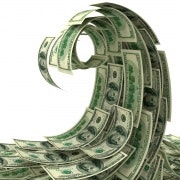My sore, Myer
Investment professionals like to dress their profession up as something complicated and mysterious. Sometimes it is. Often it is not.
Take the Myer float for instance. Enough time has now passed to get some idea of just how simple, or complicated, it was (Full coverage: Myer IPO).
At $4.10 last October, it seemed like a good idea. It's now trading at $3.50. Initial investors are collectively sharing losses of $350 million.
Last week's result was okay (Myer's moment of truth, March 11; Myer has been cut to the bone, March 11) . Consensus earnings per share (eps) and dividend per share (dps) were upgraded by 2 per cent. Seven of eight brokers I follow are recommending it to their clients with only Merrill Lynch cautious. And yet initial investors are still down 15 per cent. So what happened?
One likely reason why almost every broker continues to recommend Myer is because almost all of them urged their clients into the initial float. Their clients are suffering, so as is industry custom, the brokers must appear to suffer as well. Of course broker suffering is soothed somewhat by the collective $60 to $70 million in advisory fees they collected from the IPO.
I counted at least 13 brokers in the IPO. That's an extraordinarily high number. I always worry when such a high number of brokers take part in an IPO.
In an IPO, brokers get rewarded for selling shares to their clients, not providing independent advice about what they really think. And if they are all selling, who is looking for potential trip wires?
It was clever on the part of the vendors of course – if you involve all the brokers in the IPO process, no broker is independent. And compared to the eventual profits to be made from the sale, the $60 to $70 million in advisory fees looks like a bargain. So the first warning sign was 'too many brokers'. If this was a soccer match I'd say the score was 1-0 to the vendor.
Jen!
Another subtle warning was in the original prospectus. You didn't have to look too hard for this warning. It was emblazoned across the front cover – a photo of a smiling Jennifer Hawkins. Lovely lass; great distraction. Vendors 2, everybody else 0.
Jen pops up quite a bit in the prospectus. In case you didn't get enough on the front cover, you can find her on page 13; and again on page 32. But like the prospectus, I digress.
Page 4 tells me Myer expected to earn about 28c eps at the time of the IPO. That's a prospective PE of 14.6x. At the time the market multiple was about 16.5x. Myer seemed attractively priced at an 11 per cent discount to market. Looks like the vendors are running away with the game now; 3-0.
150 per cent return
At the time of the float I remember attending a broker lunch. I only asked one question. "How much did the vendor pay for Myer?”
Answer: $1.4 billion, in 2006. And in three years the vendor had whipped out $565 million in capital returns and dividends. So the business owed $835 million. And now the vendor wanted $2.1 billion. That represented a 150 per cent return in just three years.
The rest of that broker lunch was spent talking about new store openings and systems upgrades. But I could hardly concentrate as I dwelt on the vendor's asking price. A good analogy is a home purchase. How many of us would buy a home for 150 per cent more than its most recent selling price just three years earlier. Okay, if the home had a new coat of paint, new bathrooms and kitchens you might pay up. But you certainly wouldn't pay 150 per cent more. And certainly not when the wider market was flat during the same period. Vendor 4, everyone else 0.
Wesfarmers
Myer had originally emerged from the Coles stable. And Wesfarmers owned the rest of Coles. So my initial reaction to that Myer lunch was to focus more intently on Wesfarmers. My logic was fairly simple. If Myer had that much fat, the rest of Coles probably did as well. Since the Myer IPO, Wesfarmers has risen 14 per cent. Given the amount of fat that emerged from Myer, maybe Wesfarmers has a lot more upside yet?
Since that broker lunch I have paid zero attention to Myer. I'm sure, like Jen, it is attractive on many levels. But its register is now chock full of disgruntled investors. They have lost a packet and it's hard for them to blame anybody. So now all those original investors just want their money back. And I'm sure if they are patient enough, they'll get it back. But in future, every time Myer approaches $4.10, there will be a wall of sellers. I think I'll look at Myer once it breaks above $4.10. That should signal that initial investors have 'left the building' and then we can refocus away from human psychology and back onto the fundamentals. Until then, I suspect there will be more rewarding opportunities elsewhere in the market.
Of course having ripped out a 150 per cent gain in just three years, the vendors scored one last goal – and it was a cracker. With the tax office (ATO) asking pesky questions about capital gains, the proceeds from the IPO left the country and disappeared into the Cayman Islands in less time than it took me to write this paragraph. So the ATO was left looking incredibly stupid as well. That's no mean feat in itself. So the final insult is that the vendors hardly paid a dollar in tax on their approximate $1.1 billion gain. The final score was a massacre; 5-0.
Mike Mangan is a portfolio manager at 2MG Asset Management. Both he and the fund have a material exposure to Wesfarmers and have never owned Myer shares.















